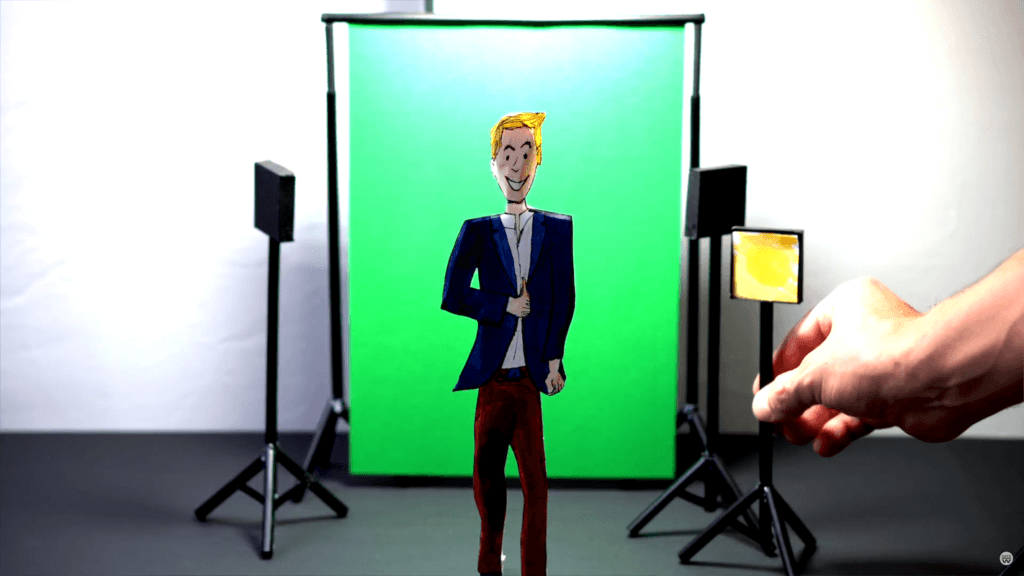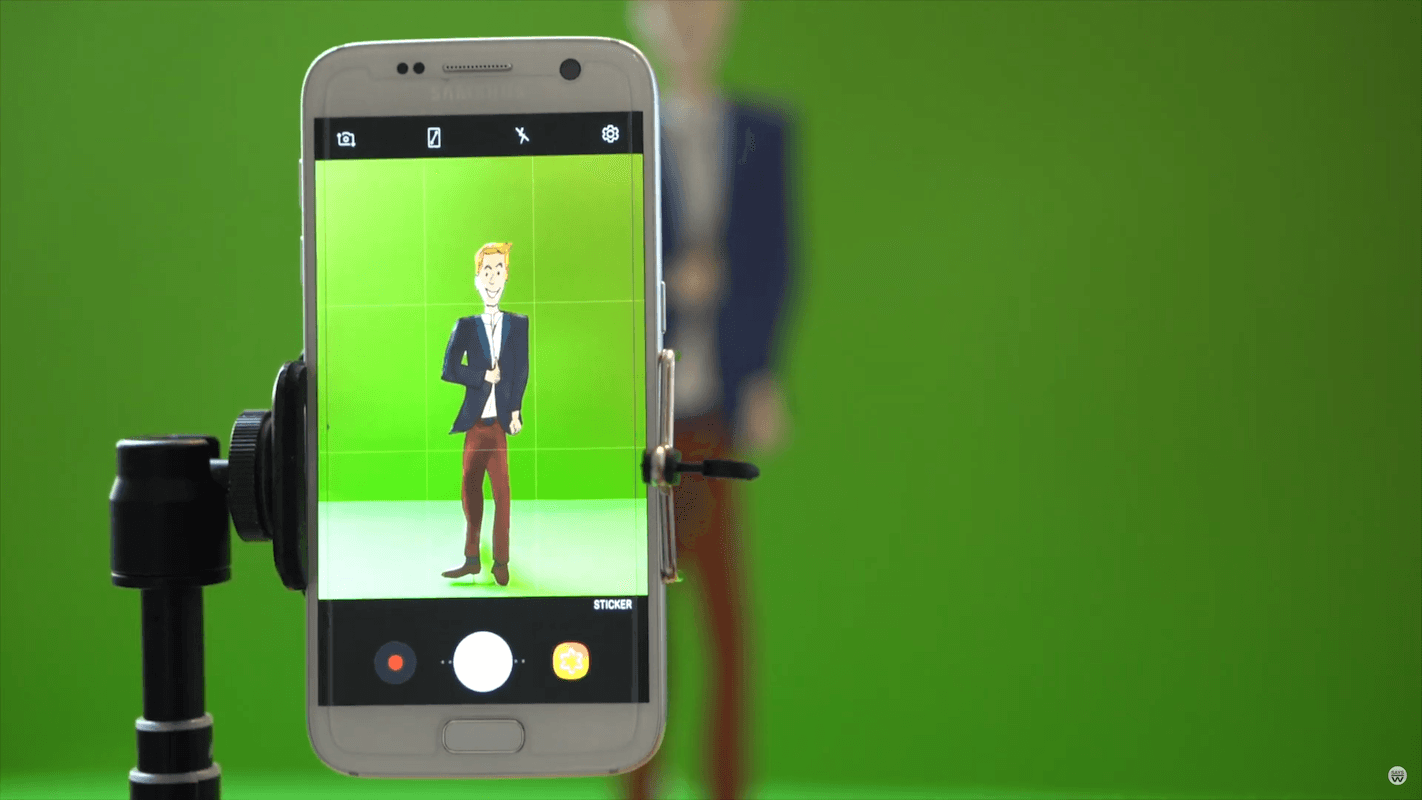Anybody can tell a story if they really want to. This bonus part should help you to do it better. The difference between telling a story live on stage at an event or talking into a camera in a closed studio isn’t as big as you’ll see below. The live conditions before a performance usually lead to a higher stress level due to stage fright, because you can simply delete the recording of the camera and restart it.
Speaking in front of the camera
In both cases a successful performance can be reproduced like this:
- Someone comes onto the stage or into the camera image in a positive mood, perhaps with a smile or a special charisma that arouses interest.
- In his speech, the speaker establishes a relationship with the audience, creates interest and satisfies curiosity.
- Through a polarizing appearance, his paraverbal and content-related statement, his characters can quickly be put into a drawer for which the listener is constantly looking for confirmation. If there is agreement, this leads to an individual build-up of trust and sympathy.
- The relationship with the speaker is put to the test if the relevance of the content for each individual is assessed. In addition, the listener asks himself whether the speaker also has the authority and competence to say something on the subject. The content of the speech can therefore be chosen strategically:
- When the speaker presents his story, he repeatedly adds elements to a successful presentation in order to maintain the positive mood towards the audience. Since people love confirmation, they can, for example, strengthen their sympathy by praising the audience, or represent points of view with which the majority identifies.
- His authority can be underpinned by figures from studies whose source is acceptable to the audience.
- If the speaker shows up with prominent experts, his competence is strengthened by the halo effect.
- Using examples, the listener can identify with a situation that leads to more relevance being attached to the presentation.
- Through the skilful dramaturgy, the speaker attracts attention and creates an arc of tension that leads to his strategic content not being perceived as such.
- The structure of his presentation produces core statements that provide agreement in the context of execution and at the same time create an emotional effect.
- The speaker optimally meets his listeners with exactly three core statements, since human logic perceives them as an acceptable structure, as was already recognized in ancient poetry.
- The emotional state of the speaker determines the details of his presentation, with the core statements serving as intermediate goals.
- A successful end combines the core messages into a punch line and fulfils the expectations of the listeners. Curiosity is satisfied, promises are kept and emotions experienced are enriching. If the speaker envisages a call to action, his storytelling strengthens the effect of the appeal.
A speaker sits on the driver’s seat as a narrator and takes his audience on a journey. But this does not lead to himself, for example where he stands today or will arrive some day, but to something of higher relevance that offers his audience an inspiring added value.
I think that I can speak in front of the camera. I think my fighting ability can speak for itself as well.
Rose Namajunas
The punch line and the final sentence pay for a speech, because the effect in the end justifies all the effort needed for the story, the studio or the event.
A good punch line will be remembered for LONG LIFE!
While a speaker in front of the camera should continuously look into the lens, a speaker on stage maintains eye contact with the audience. Often the interaction with the camera is easier again, because eye contact is not possible even on stage. The sighting of attentive eyes in the audience must first succeed, whereby spotlights often ensure that the speaker only perceives a garish crowd from above.

Imagine telling your story to a good friend if you have trouble speaking into the soulless camera. If you address everyone, you won’t reach anyone. So rather concentrate on one particular person you represent as a camera, enthusiastically telling your story. You can even flirt with her to create an even closer relationship.
Unlike a photo, a video gives you a deeper insight into your personality. This must come across harmoniously and authentically. A self-contained thinker can hardly stage himself with “KAHBUHH, we make that!” in order to motivate a team of 600 seasoned salespeople. On the other hand, just like on stage, it’s also important to keep the audience in front of the camera by slightly exaggerating.
The rhetoric is the key to the character. It’s the verbal music of the piece.
Peter Shaffer
The stage offers a lot of space, which has to be filled first. That’s exactly what an audience expects, even if it’s the natural reaction of a person who hasn’t already been blunted as a showmaster to be excited and frightened. So your audience doesn’t want to see you, they expect to be entertained and to hear a story that gives them clarity.

That’s why it’s important to stage yourself a bit in front of the camera. The added value for the viewer must be in the foreground. A business Jesus not only wears long hair to define himself, but also helps his audience to see him credibly.
If the investment punk Gerald Hörhan would appear as a normal banker in a pinstriped suit, this would be an abuse of his name, even if he actually takes unconventional and rebellious paths with regard to his investment strategies. Therefore, it is always important that your production fits you as you define yourself. Are you rather loud or quiet, provocative or funny – an inconspicuous nerd or maybe a freak with extreme potential? Show it.

Even reserved stagings will help you to authentically represent your brand and positioning. Mario Barth, for example, wore a simple yellow T-shirt at the beginning of his career in which he felt comfortable and authentic. The inscription “Frau Deutsch, Deutsch Frau”, however, immediately showed how he was positioned as a comedian, even if you only listened to him for a few minutes. Good speakers show corners and edges in their staging, true to the motto: Every brand has a flaw.
If you succeed in putting out what you stand for and what you don’t stand for, you will polarize your audience more strongly and be remembered better. Pointe that are exaggerated or provocatively portrayed show the most powerful effect that can set aha-moments and impulses. Entertain your audience by making yourself a little bigger than you actually are.
After all, that’s the task for the person standing on stage. There’s no community up there like you’re supposed to have in the office among colleagues. If you can be seen on stage or in the video, you are like a king who takes his people further through storytelling.
If theatre actors didn’t make themselves a little bigger in their roles, people would fall asleep on the back rows. It doesn’t matter whether you talk into the camera or stand on stage. The space that is offered to you must first be filled.

The best way to start your speech is with a promise to the listener, which has a surprising effect. A website visitor can imagine that at the end there is the possibility to send his request via a contact form. If, on the other hand, you start with a pattern interruption such as “Do you know what I hate like the plague? Why is a nice visitor like that hit by you?
Try to tell your story freely using keywords, because you can only reproduce texts learned by heart vividly with difficulty. A telepromter can be used well for factual information, like I do with these contents here, but with storytelling it is counterproductive, because emotions are more important than the completeness of what you want to tell. Completeness is not compatible with free speech.
Your core statements are the exceptions. Memorize them as well as the first and last few sentences including your punch line, so that you don’t weaken the magic of these words. “Uhh’s” and pauses should be avoided at these critical points of your speech. In the actual content of your narrative these are less bad.
Use a keyword system based on a mindmap star to better remember the individual topic blocks. An optimal structure allows you to change the order so that your presentation gets more individuality through free speech.

